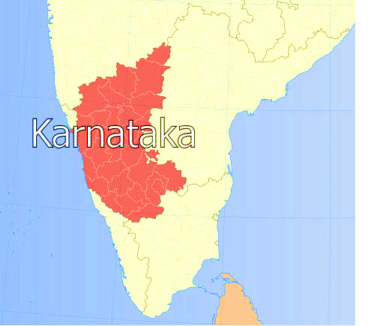
(Bildquelle: PlaneMad/Wikipedia. -- CC-by-sa)

(Bildquelle: PlaneMad/Wikipedia. -- CC-by-sa)
Zitierweise / cite as:
Hodson, Thomas: An elementary grammar of the Kannada, or Canarese language. -- 7. Verbs (§§ 102 - 108). -- Fassung vom 2011-08-24. -- URL: http://www.payer.de/hodson/hodson07.htm
First published as: Hodson, Thomas: An elementary grammar of the Kannada, or Canarese language ; in which every word used in the examples is translated, and the pronunciation is given in English characters. -- 2. ed. -- Bangalore : Wesleyan Mission Press, 1864. -- 128 p. ; 23 cm.
First time published here: 2011-08-24
Revisions:
©opyright: Public domain
This text is part of the section Sanskrit und Indien of Tüpfli's Global Village Library
If you don't get the diacritics displayed, install a Unicode font like Tahoma.
102. Verbs are divided into
The root of the verb is generally the same as the 2nd pers. sing. Imperative.
103. The roots of verbs generally terminate in ಉ u, ಇ i, ಎ e, or ಏ ē.
104. There are two Conjugations, distinguished by the ending of the root of the verb.
105. There are four Simple Moods [ರೂಪ rūpa]; viz.
The Potential and the Subjunctive [ಸಂಶಯರೂಪ saṃśayarūpa] are compounds.
106. In the Affirmative mood there are four simple, and six compound Tenses [ಕಾಲ kāla].
107. The Infinitive mood is impersonal. The other simple moods and tenses are formed by adding certain personal affixes
108. The following are the personal affixes used in the conjugation of Verbs.
| Singular | Plural | Added to | |||||||||
| 1 | 2 | 3 m. | 3 f. | 3 n. | 1 | 2 | 3 m. & f. | 3 n. | |||
| Negative Mood [ನಿಷೇಧ niṣēdha] |
ಎನು enu1 |
ಎ
e |
ಅನು
anu1 |
ಅಳು
aḷu |
ಅದು
adu |
ಎವು
evu |
ಅರಿ
ari |
ಅರು
aru |
ಅವು
avu |
the Root | |
| Affirmative Mood [ನಿಶ್ಚಯರೂಪ niścayarūpa] |
1st Future Tense4 [ಭವಿಷ್ಯತ್ತು bhaviṣyattu] |
ಇ i or ಎ e |
ಇರಿ iri |
the future relative participle ending in ಉವ uva | |||||||
| Past Tense5 [ಭೂತ - bhūta] |
ಇತು
itu2 |
past relative participle in ದ da | |||||||||
| Conditional Future6 | ಏನು ēnu |
ಈ
ī or ಈಯೆ īye |
ಆನು
ānu |
ಆಳು
āḷu |
ಈತು
ītu |
ಏವು
ēvu |
ಈರಿ īri |
ಆರು āru |
ಆವು āvu |
past gerund in ಇ i and ದು du | |
| Present Tense7 [ವರ್ತಮಾನ - vartamāna] |
ಏನೆ ēne |
ಆನೆ āne |
ಆಳೆ āḷe |
ಅದೆ ade3 or ಎ e |
ಏವೆ ēve |
ಆರೆ āre |
ಆವೆ āve3 |
present gerund in ಯುತ್ತ yutta | |||
1 ನು nu, may be omitted, except in the Conditional future tense (§ 222).
2 ಇತು itu, is irregular and cuts the final ಅ a, of the participle to which it is affixed.
3 Irregular affix.
4 These affixes are the same as the Negative mood, except in the 2nd. persons.
5 Same as the 1st. Future, except in the 3rd. person singular neuter.
6 In these the final vowels of the past tense affixes are lengthened.
7 The final ಉ u, of the conditional-future affixes are changed to ಎ e.
To 8. Conjugation of the auxiliary irregulary verb ಇರು irಉ (§ 109)